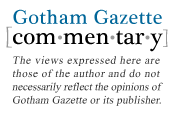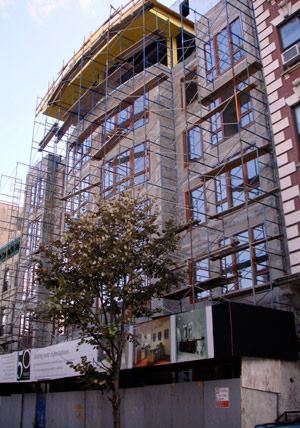Getting Families Out of Shelters and Into Homes
Homeless families won the right to shelter, enforceable in the courts, this past week. It was a huge victory - 25 years in the making. The settlement of the litigation, originally brought against the Koch administration, came on the brink of a trial at which homeless mothers were poised to testify in open court about their recent treatment while attempting to get into emergency shelter.
In short, they and their children had to sleep on the streets, in subway stations, parks, laundromats and all-night fast food restaurants. Coming on the heels of a damming Independent Budget report last month, the last thing city officials wanted was graphic sworn testimony on the toll Mayor Michael Bloomberg's homeless policy had taken on mothers with vulnerable children.

The other looming backdrop is near record family homelessness in New York City. How did we get into this mess and how do we work our way back out of it?
The Bloomberg Record
Four years ago, Bloomberg committed to reduce New York City homelessness by two thirds over five years. His ambitious goals were praised by a wide array of advocates, service providers and community groups. But many remained concerned that the mayor did not commit sufficient housing resources to the problem and had failed to craft the policies needed to achieve his goal.
In recent years, those fears were sadly realized as the Bloomberg administration stumbled through a series of flawed approaches to homelessness - from the administration's decision to cut off homeless New Yorkers from federal housing assistance, beginning in autumn 2004; to the disastrous "Housing Stability Plus" program, which the city finally abandoned in early 2007; to the deeply flawed "Work Advantage" program which replaced Housing Stability Plus; to the city's ongoing and accelerating use of illegal boarding houses to shelter homeless adults living with mental illness and other disabilities.
Most troubling, New York City's homeless population has risen dramatically in recent years. Every night since Bloomberg took office, more than 30,000 homeless New Yorkers have resided in shelters, a higher number than at any point in the 1980s or 1990s. In June, over 8,600 homeless families with more than 14,000 children bedded down each night in municipal shelters, only slightly fewer than when the mayor unveiled his plan four years ago.
The Independent Budget Office's recent report documented the clear failures of the mayor's plan. In short, four years after Bloomberg announced his proposal for reducing homelessness, New York City's homeless population is dramatically larger than the targets in the plan. In fact, more New Yorkers are homeless than when Bloomberg took office.
All in all, the current decade has proven to be the worst for New York City homelessness since the Great Depression of the 1930s.
Last week's historic legal settlement codifies an enforceable right to shelter for homeless families along with specific enhancements in intake procedures by the Department of Homeless Services. But intake - the front end of the shelter system - is only half of the equation. If New York is to see real reductions in the number of families residing in shelters each night, the city must make substantial changes in its approach to housing homeless families.
Reducing Family Homelessness
The Independent Budget Office's findings and rising family homelessness should serve as a call to arms. They should spur Bloomberg administration officials to abandon their failed homeless housing policy and to embrace proven, cost-effective solutions to radically reduce homelessness in New York City.
Perhaps most importantly, the mayor and administration officials remain mired in the false notion that family homelessness is a behavioral problem, not what it primarily is: a housing affordability problem. Thus, addressing it must involve proven, housing-based solutions.
Following is a summary of immediate steps the city can take to change course and genuinely reduce family homelessness:
-- Target Federal Housing Aid to the Homeless: In late 2004, the Bloomberg administration cut off homeless New Yorkers from longstanding priority for federal housing programs, including Section 8 vouchers and public housing. In January 2007, Bloomberg announced that the city would give out 22,000 new Section 8 vouchers - none to the homeless.
Reversing the city's misguided policy will move thousands of homeless families to permanent housing - and save city taxpayer dollars spent on emergency shelter.
-- Repair the Flaws in Rental Assistance Programs for the Homeless: Over the past four years, the city has created two flawed rental assistance programs for homeless New Yorkers. The "Work Advantage" program has unrealistic, one-size-fits-all time limits that cut off rental assistance to struggling families after two years - regardless of a family's circumstances. In contrast, acclaimed studies by the Vera Institute, the National Alliance to End Homelessness and academic researchers have found that long-term, flexible housing assistance - like the federal Section 8 voucher program - enables families to move from shelter to their own homes and helps them stay there.
The city should repair the flaws in the "Work Advantage" program and ensure that families in need are guaranteed housing assistance after the time limits.
-- Expand Homelessness Prevention Services: The annual cost of sheltering a homeless family is $33,000. In contrast, prevention services, which help keep struggling families in their homes, cost a fraction of that amount. The Independent Budget Office found that, while the city spends more than $650 million annually on shelter, it spends less than $200 million on homelessness prevention. The recently adopted budget actually cut legal services aimed at preventing homelessness and other prevention programs by more than $3 million.
The city should expand homelessness prevention legal services, the Homeless Prevention Fund, and other prevention programs.
Patrick Markee is a senior policy analyst for the Coalition for the Homeless. Mary Brosnahan is the coalition's executive director.
Â
The Long Fight to End Homelessness
A landmark settlement. A critical report. Calls to action.

In the last months, homeless advocates and city officials have seen an array of steps forward - and back - in the fight to end homelessness.
One recent report identified an increase in the amount of homeless families in the city. It also solidified arguments that the Bloomberg administration was far from reaching its goal, put forth in 2004, of reducing the homeless population by two thirds in 2009. Just last week, the Bloomberg administration announced a landmark settlement in a 25-year-old lawsuit, releasing the city from court oversight of its shelter system, while simultaneously guaranteeing New York's families a right to shelter.
These recent developments have not answered the most fundamental questions: Is New York City doing enough to combat homelessness? And what more could - and should -- it do?
In 2004, when Mayor Michael Bloomberg announced his ambitious five-year plan on homelessness, about 37,319 individuals lived in shelters or on the streets. Last week, according to estimates from the Department of Homeless Services, there were 34,299. That is a decrease of just over 8 percent - far from the mayor's laudable goal.
The mayor's figures in his recent Mayor's Management Report give a further indication of the difficulties his administration has had reducing homelessness. While slightly fewer people -- including single adults, adult families and children with families -- go to shelters on an average day, the number of families with children in the shelters has increased since the 2005 fiscal year and in 2008, reached 7,802 families a day.
With one year left to go in this administration, many say the mayor will likely fail to reduce homelessness like he pledged to do. Earlier this year, New York Magazine termed the fight to reduce homelessness as "the single biggest failure of the Bloomberg administration." While supporters see progress, almost no one denies that Bloomberg's efforts at fighting homelessness have fallen far short of his ambitious goals.
In our package of articles, several advocates and officials examine what went right - and wrong.
Getting Families Out of Shelters and Into Homes
by Patrick Markee and Mary Brosnahan
While this week's legal settlement was historic in that it enshrined the right to shelter for city families, New York must do far more to lower the homeless population, say the executive director and senior policy analyst at the Coalition for the Homeless.
Prevention is the Best Medicine
by Bill de Blasio
The chair of the City Council's General Welfare Committee suggests several ways to better combat homelessness, such as investing more funding in prevention.
On Track to Ending Homelessness
by George T. McDonald
The president and founder of the Doe Fund writes that no administration has been more innovative, forward-thinking and successful than Mayor Michael Bloomberg's at tackling the challenges of homelessness.
Handing out to the Homeless
by Courtney Gross
Gotham Gazette rides with a group of volunteers distributing meals to Lower Manhattan's homeless.
Fighting Homelessness in Miami
by Ronald Book and David Raymond
In the early 1990s, Miami was overrun with homelessness. Now, thanks to a one-cent tax on certain restaurant meals, the area has become a national model getting people off the streets and into housing and other programs.
( The city's Department of Homeless Services declined to contribute to this package. )
Â
Cutting the High Cost of Housing
Even as the housing market falters in much of the nation, houses and apartments in New York City remain expensive. A relatively modest condominium in a prime neighborhood can go for more than a million dollars, making it difficult for many New Yorkers who do not have that kind of money to find a suitable home.
Why is housing so expensive in New York City? There are a number of reasons, but one, often overlooked, is that it costs so much more to build here than in other cities. Moreover, the difference has grown even more marked as the cost of residential construction has increased rapidly in the past five years. As documented in a recent study by economist Rosemary Scanlon, commissioned by the Manhattan Institute, rising costs, driven by steep increases in the costs of materials, land and labor, and the delays and resulting high costs of the local permitting and regulatory process, pose a serious threat to constructing housing that is affordable for low- and middle-income New Yorkers.

Since 2003, these costs have been rising as much as 1 percent each month, as global demand caused material prices to soar, while the city's boom in construction made it difficult to find skilled contractors and labor and pushed up land prices throughout the five boroughs.
The current scarcity of available capital further threatens continued construction of housing that is affordable to New York households. The year-long credit crunch has made it harder to get construction loans as well as individual mortgages. In addition, dramatic changes have been made to the city's 421-a tax abatement program for housing, and while the full impact remains to be seen, several developers of affordable housing have publicly expressed deep concerns over possible adverse effects.
Adding Up the Costs
Costs of building materials have been rising rapidly since 2003, driven by strong growth in Asia and other emerging economies around the globe. In New York City, the current boom in construction has contributed as well. Labor costs, which have long been higher in the city for the unionized trades, are being pushed up by strong demand and overtime, which has also strained the capacity of available contractors and subcontractors.
Construction of offices and hotels, along with condos and co-ops, has used much of the available land, driving up land prices in Manhattan's central core. But not just there. Land has grown in value in northern Manhattan and the other boroughs, particularly Brooklyn and the Bronx. For example, land in downtown Brooklyn that sold in the range of $70 per square foot in early 2005 was selling for around $250 per square foot by mid-2007. Citywide, increases in land prices are now the single most important factor in the cost of building housing.
New York's vast array of building codes, regulations and required permits also add a significant premium to construction costs. Navigating the system demands the expertise of highly specialized legal and architectural professionals.
New York's Unique Housing Market
The city's housing situation, both on the demand and supply side, remains an exception to patterns in many other cities and regions of the U.S., as prices still are increasing here and demand for housing remains intense.
Population growth since 2000 and the strong post-2003 economy have put additional pressure on New York's already scarce housing supply. The demand is reflected in the number of building permits issued for residential construction - up from levels of 15,000 units per year in 2000, 2001 and 2002, to 30,000 units per year in 2005, 2006 and 2007. Demand has pushed up prices for condominiums, co-ops and rentals in Manhattan and Brooklyn. Rents in stabilized buildings have continued to rise as well.
However, fewer building permits were issued in the early months of 2008. Some local experts contend this drop-off reflects heightened activity in 2007 by housing developers hurrying to file for permits before changes in the 421-a tax abatement program went into full effect this July 1. Data on building permit activity in the last months of the year will give a better indication of whether this cooling off is temporary, or a delayed response to national trends.
After a brief easing during 2007, some material costs are again increasing steeply. Prices for steel and steel products rose 15 percent nationwide from August 2007 to August 2008. The sharp increases in oil prices in the first half of 2008 drove up costs of transportation as well as petroleum products, including an increase of over 11 percent in the price of asphalt products.
These trends affecting the cost and price of housing come at a time when the inflation-adjusted incomes of most New Yorkers have failed to show real gains. The rise in local inflation - over 25 percent since 2000 - has been greater than the increase in median household incomes. And housing costs in the same years have risen even faster than the rate of inflation-on average by 33 percent. Thus New York's crisis in housing affordability is a function of available income as well as the cost of construction.
What Can Be Done?
Since national and international trends determine many of the cost components, it is necessary to focus on what City Hall and Albany can influence.
* Reduce delays in construction time, and thus cost, by streamlining the city's regulatory and permitting processes. Opportunities include processing and issuing permits in parallel rather than sequentially and improving inter-agency coordination (e.g. between Department of Buildings and the Department of Transportation). Many inefficiencies contribute nothing to the safety of workers and the public (and perhaps detract from it, in creating confusion) while adding time and expense to the process. Having related permits from buildings and transportation expire simultaneously with project insurance, for example, would reduce developer headaches and expense without changing safety requirements.
* Increase the supply of buildable land by continuing the Bloomberg administration's progress in rezoning old industrial land and upzoning areas that could support greater residential and commercial density. Areas near subway stations outside of Manhattan's central business district could support greater density. More land could also be made available for housing by changing the regulations that require housing developments outside central Manhattan to provide parking spaces on-site. Similarly, eliminating requirements for on-site garage space could save $30,000 to $50,000 for each space not built.
In addition, costs of building affordable housing can be held down by using non-union labor. Currently, some contractors use union labor and others use non-union; often there is a mix. Developers make project-by-project decisions about which way to go, as union labor in certain specialized fields is efficient enough on some projects to offset higher wages and generous benefits and work rules. But construction unions are now lobbying city and state lawmakers to require "prevailing" (i.e., union-equivalent) wages on housing built with public subsidies. To foster building for all price ranges and income levels, it is essential that the city and state keep the non-union option available, especially for affordable housing outside the Manhattan central business district.
High rates for liability insurance also add to the burden of building costs in New York City. One major reason is New York State's Scaffold Law, a century-old piece of legislation that imposes absolute liability on the builder or owner if a worker falls from a scaffold or bridge, regardless of whether that worker has been negligent. New York State is the only state in the nation that has not adopted the provision of comparative liability. This discourages new insurers from entering the New York market and keeps premiums up.
The shortage of affordable housing is a multi-faceted problem, and no silver bullet can solve it. But there are some things the city and state can to do to improve the situation, notably common-sense streamlining along with expansion of the supply of land, contractors and even insurance providers. The state and city governments need to take those actions now if New York City is going to continue to be home to people of all incomes, occupations and backgrounds.
Rosemary Scanlon is a consultant in urban and regional economics as well as an associate professor at the NYU Schack Institute of Real Estate. Hope Cohen is deputy director of the Manhattan Institute's Center for Rethinking Development. Â





